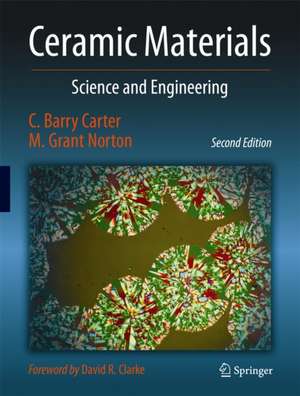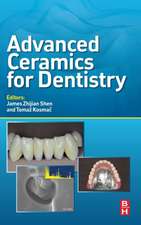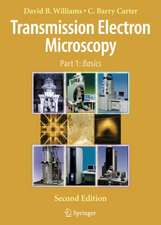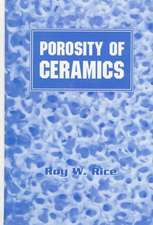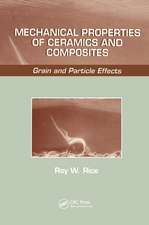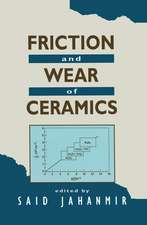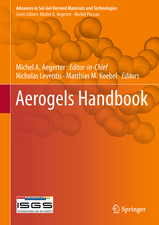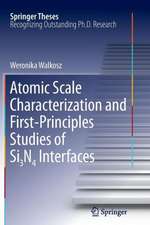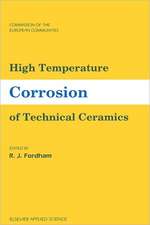Ceramic Materials: Science and Engineering
Autor C. Barry Carter, M. Grant Nortonen Limba Engleză Hardback – 28 ian 2013
This course-tested text now includes expanded chapters on the role of ceramics in industry and their impact on the environment as well as a chapter devoted to applications of ceramic materials in clean energy technologies. Also new are expanded sets of text-specific homework problems and other resources for instructors. The revised and updated Second Edition is further enhanced with color illustrations throughout the text.
| Toate formatele și edițiile | Preț | Express |
|---|---|---|
| Paperback (1) | 576.41 lei 6-8 săpt. | |
| Springer – 23 aug 2016 | 576.41 lei 6-8 săpt. | |
| Hardback (1) | 693.23 lei 38-45 zile | |
| Springer – 28 ian 2013 | 693.23 lei 38-45 zile |
Preț: 693.23 lei
Preț vechi: 900.30 lei
-23% Nou
Puncte Express: 1040
Preț estimativ în valută:
132.65€ • 138.49$ • 109.78£
132.65€ • 138.49$ • 109.78£
Carte tipărită la comandă
Livrare economică 31 martie-07 aprilie
Preluare comenzi: 021 569.72.76
Specificații
ISBN-13: 9781461435228
ISBN-10: 1461435226
Pagini: 766
Ilustrații: XXXIII, 766 p.
Dimensiuni: 210 x 279 x 38 mm
Greutate: 2.38 kg
Ediția:2nd ed. 2013
Editura: Springer
Colecția Springer
Locul publicării:New York, NY, United States
ISBN-10: 1461435226
Pagini: 766
Ilustrații: XXXIII, 766 p.
Dimensiuni: 210 x 279 x 38 mm
Greutate: 2.38 kg
Ediția:2nd ed. 2013
Editura: Springer
Colecția Springer
Locul publicării:New York, NY, United States
Public țintă
ResearchCuprins
Preface to the First Edition.- Preface to the Second Edition.- Foreword.- PART I: History and Introduction.- Chapter 1: Introduction.- Chapter 2: Some History.- PART II: Materials.- Chapter 3: Background You Need to Know.- Chapter 4: Bonds and Energy Bands.- Chapter 5: Models, Crystals and Chemistry.- Chapter 6: Binary Compounds.- Chapter 7: Complex Crystal and Glass Structures.- Chapter 8: Equilibrium Phase Diagrams.- PART III: Tools.- Chapter 9: Furnaces.- Chapter 10: Characterizing Structure, Defects and Chemistry.- PART IV: Defects.- Chapter 11: Point Defects, Charge and Diffusion.- Chapter 12: Are Dislocations Unimportant?.- Chapter 13: Surfaces, Nanoparticles and Foams.- Chapter 14: Interfaces in Polycrystals.- Chapter 15: Phase Boundaries, Particles and Pores.- PART V: Mechanical Strength and Weakness.- Chapter 16: Mechanical Testing.- Chapter 17: Plasticity.- Chapter 18: Fracturing: Brittleness.- PART VI: Processing.- Chapter 19: Raw Materials.- Chapter 20: Powders, Fibers,Platelets and Composites.- Chapter 21: Glass and Glass-Ceramics.- Chapter 22: Sols, Gels and Organic Chemistry.- Chapter 23: Shaping and Forming.- Chapter 24: Sintering and Grain Growth.- Chapter 25: Solid-State Phase Transformations & Reactions.- Chapter 26: Processing Glass and Glass-Ceramics.- Chapter 27: Coatings and Thick Films.- Chapter 28: Thin Films and Vapor Deposition.- Chapter 29: Growing Single Crystals.- PART VII: Properties and Applications.- Chapter 30: Conducting Charge or not.- Chapter 31: Locally Redistributing Charge.- Chapter 32: Interacting with & Generating Light.- Chapter 33: Using Magnetic Fields & Storing Data.- Chapter 34: Responding to Temperature Changes.- Chapter 35: Ceramics in Biology & Medicine.- Chapter 36: Minerals & Gems.- Chapter 37: Energy Production and Storage.- Chapter 38: Industry and the Environment.
Recenzii
From the book reviews:
“I will definitely select this book as a textbook for a class on this subject. … The book includes general backgrounds materials, the basics of ceramic materials science and advanced applications of ceramic science and technology. Therefore, non-specialists (even non-science majors) including undergraduate, and graduate students as well as experts in the field can learn from various parts of in this book.” (Katsuhiko Ariga, Journal of Inorganic and Organometallic Polymers and Materials, Vol. 24, 2014)
“I will definitely select this book as a textbook for a class on this subject. … The book includes general backgrounds materials, the basics of ceramic materials science and advanced applications of ceramic science and technology. Therefore, non-specialists (even non-science majors) including undergraduate, and graduate students as well as experts in the field can learn from various parts of in this book.” (Katsuhiko Ariga, Journal of Inorganic and Organometallic Polymers and Materials, Vol. 24, 2014)
Notă biografică
Dr. Carter is the co-author of two textbooks (the other is Transmission Electron Microscopy: A Textbook for Materials Science with David Williams), co-editor of six conference proceedings, and has published more than 290 refereed journal papers and more than 400 extended abstracts/conference proceedings papers. Since 1990 he has given more than 120 invited presentations at universities, conferences and research laboratories. Among numerous awards, he has received the Simon Guggenheim Award (1985-6), the Berndt Matthias Scholar Award (1997/8) and the Alexander von Humboldt Senior Award (1997). He organized the 16th International Symposium on the Reactivity of Solids (ISRS-16 in 2007). He was an Editor of the Journal of Microscopy (1995-1999) and of Microscopy and Microanalysis (2000-2004); he continues to serve on the Editorial Board of both journals.
M. Grant Norton is Professor of Materials Science and Engineering in the School of Mechanical and Materials Engineering at Washington State University. From 2005 to 2011 he served as Associate Dean of Research and Graduate Programs in the College of Engineering and Architecture. Professor Norton obtained his PhDin Materials from Imperial College, London, in 1989,under the direction of Professor B.C.H. Steele and spent a two-year postdoctoral at Cornell University with Professor C. Barry Carter before joining the Washington State University faculty in 1991. In 2003 and 2004 he was an Air Force Office of Scientific Research (AFOSR) Faculty Research Associate at Wright-Patterson Air Force Base in Ohio and spent the 1999/2000 academic year as a Visiting Professor in the Department of Materials at Oxford University. From 2000 to 2005 Professor Norton was Chair of Materials Science at Washington State University and from 2004 to 2007 he held the Herman and Brita Lindholm Endowed Chair in Materials Science. He is author or co-author of about 200 papers in the archival literature, several bookchapters, and two textbooks.
M. Grant Norton is Professor of Materials Science and Engineering in the School of Mechanical and Materials Engineering at Washington State University. From 2005 to 2011 he served as Associate Dean of Research and Graduate Programs in the College of Engineering and Architecture. Professor Norton obtained his PhDin Materials from Imperial College, London, in 1989,under the direction of Professor B.C.H. Steele and spent a two-year postdoctoral at Cornell University with Professor C. Barry Carter before joining the Washington State University faculty in 1991. In 2003 and 2004 he was an Air Force Office of Scientific Research (AFOSR) Faculty Research Associate at Wright-Patterson Air Force Base in Ohio and spent the 1999/2000 academic year as a Visiting Professor in the Department of Materials at Oxford University. From 2000 to 2005 Professor Norton was Chair of Materials Science at Washington State University and from 2004 to 2007 he held the Herman and Brita Lindholm Endowed Chair in Materials Science. He is author or co-author of about 200 papers in the archival literature, several bookchapters, and two textbooks.
Textul de pe ultima copertă
Ceramic Materials: Science and Engineering is an up-to-date treatment of ceramic science, engineering, and applications in a single, comprehensive text. Building on a foundation of crystal structures, phase equilibria, defects, and the mechanical properties of ceramic materials, students are shown how these materials are processed for a wide diversity of applications in today's society. Concepts such as how and why ions move, how ceramics interact with light and magnetic fields, and how they respond to temperature changes are discussed in the context of their applications. References to the art and history of ceramics are included throughout the text, and a chapter is devoted to ceramics as gemstones. This course-tested text now includes expanded chapters on the role of ceramics in industry and their impact on the environment as well as a chapter devoted to applications of ceramic materials in clean energy technologies. Also new are expanded sets of text-specific homework problems and other resources for instructors. The revised and updated Second Edition is further enhanced with color illustrations throughout the text.
Integrates the excitement of new advances in ceramics, including nanotechnology, medicine and clean energy, with fundamental concepts such as structure and defects
Explores the environmental and economic impact of ceramics on society
Describes the use of ceramics as the basis for many of today’s critical technologies, including drug delivery, orthopedic implants, sensors and catalysis
Presents a comprehensive discussion on how today’s ceramics are processed, from nanotubes and thin films to bottles and toilets
Offers abundant examples and full-color illustrations relating theory to practical applications
Addresses undergraduate and graduate teaching needs and provides a comprehensive reference for all scientists and engineers
Written by established and successful teachers and authors with experience in education, research and industry
Praise for Ceramic Materials:
“The unprecedented completeness of this book makes it a bible on ceramic materials. It is a must read textbook for researchers, graduate students and undergraduate students who are interested in ceramics.” -- Zhong Lin Wang, Regents’ Professor, The Hightower Chair in Materials Science and Engineering, Georgia Institute of Technology
“…an outstanding introduction to the subject, clearly written, very detailed, and actually fun and quite easy to read for anyone with some basic scientific background. Each chapter contains several exercises, which this reviewer found to be very helpful. I also found extremely useful the shaded boxes on almost every page with short definitions plus “people in history”. After being exposed to many books on ceramic science during my 40-year career, I finally found a book with which I can restart my ceramic education again.” --Antoni Tomsia, Lawrence Berkeley National Laboratory
“…a valuable resource for the materials science and engineering community, both as a textbook and as a general reference to this important field….recommended reading and a serious study source for anyone interested in ceramics...” --Richard W. Siegel, Director, Rensselaer Nanotechnology Center, Rensselaer Polytechnic Institute
“The book is just wonderful, and one can only envy what the authors have done! It is the best book I have seen to date. Very clearly written with excellent examples and explanations [as well as] beautiful figures and photographs.” --Professor Safa Kasap, Canada Research Chair in Electronic and Optoelectronic Materials, University of Saskatchewan
“This new book…covers all important topics including history, microstructures, tools, defects, mechanical properties and processing of ceramics for understanding and solving the problems of ceramic science and engineering,...” --Yuichi Ikuhara, The University of Tokyo
“This is a comprehensive text covering, as the title suggests, both the science and engineering of ceramic materials. What I particularly like about the presentation of the material is it that it is broken down into useful themed sections where related topics are grouped together….This will be a very useful text for MSE undergraduate ceramic courses and for post graduates starting MSc or PhD work and who are new to the field of ceramic materials.” -- Professor John Kilner, BCH Steele Chair in Energy Materials, Department of Materials, Imperial College London
“Ceramic Materials: Science and Engineering is a very thorough book….Its uniqueness lies in the coverage of fundamentals…[as well as] properties and applications…at an unparalleled level, while also providing excellent sections on defects and processing....Carter and Norton’s book is a must have in the ceramics field.” --Juan Claudio Nino, UFRF Professor, Department of Materials Science and Engineering, University of Florida, Gainesville
“It is no mean task to compete with Kingery et al.'s classic textbook on the subject, but the authors have managed to provide a fresh new perspective on the subject with their unique and student-friendly writing style coupled with spectacular graphics and micrographs…. a truly remarkable text that is bound to become a benchmark in the field.” --N. Ravishankar, Materials Research Centre, Indian Institute of Science
“…an excellent introductory textbook and basic reference for students and professionals interested in the field of technical ceramics…. There are two aspects which set this book apart from most specialty engineering text books. First, this book is replete with micrographs, photographs, and diagrams that complement the refreshingly easy-to-read text. Second, the authors discuss the field of technical ceramics in a societal context that will help novices understand why ceramics are important to our pastand future. In summary, I highly recommend this text.” -- Doreen Edwards, Dean and Professor of Materials Science, Inamori School of Engineering at Alfred University
“As a practitioner of ceramic science and technology over the last twenty five years, I was truly amazed with the easy to understand and quite innovative presentation approach of various contents in the book….This book provides a comprehensive look at various topics from the fundamental aspects of ceramics to the properties required for various applications….. I am sure this book will serve a key reference to students, technology developers, and end users all over the world.”-- Dr. M. Singh, Chief Scientist, Ohio Aerospace Institute, NASA Glenn Research Center
Integrates the excitement of new advances in ceramics, including nanotechnology, medicine and clean energy, with fundamental concepts such as structure and defects
Explores the environmental and economic impact of ceramics on society
Describes the use of ceramics as the basis for many of today’s critical technologies, including drug delivery, orthopedic implants, sensors and catalysis
Presents a comprehensive discussion on how today’s ceramics are processed, from nanotubes and thin films to bottles and toilets
Offers abundant examples and full-color illustrations relating theory to practical applications
Addresses undergraduate and graduate teaching needs and provides a comprehensive reference for all scientists and engineers
Written by established and successful teachers and authors with experience in education, research and industry
Praise for Ceramic Materials:
“The unprecedented completeness of this book makes it a bible on ceramic materials. It is a must read textbook for researchers, graduate students and undergraduate students who are interested in ceramics.” -- Zhong Lin Wang, Regents’ Professor, The Hightower Chair in Materials Science and Engineering, Georgia Institute of Technology
“…an outstanding introduction to the subject, clearly written, very detailed, and actually fun and quite easy to read for anyone with some basic scientific background. Each chapter contains several exercises, which this reviewer found to be very helpful. I also found extremely useful the shaded boxes on almost every page with short definitions plus “people in history”. After being exposed to many books on ceramic science during my 40-year career, I finally found a book with which I can restart my ceramic education again.” --Antoni Tomsia, Lawrence Berkeley National Laboratory
“…a valuable resource for the materials science and engineering community, both as a textbook and as a general reference to this important field….recommended reading and a serious study source for anyone interested in ceramics...” --Richard W. Siegel, Director, Rensselaer Nanotechnology Center, Rensselaer Polytechnic Institute
“The book is just wonderful, and one can only envy what the authors have done! It is the best book I have seen to date. Very clearly written with excellent examples and explanations [as well as] beautiful figures and photographs.” --Professor Safa Kasap, Canada Research Chair in Electronic and Optoelectronic Materials, University of Saskatchewan
“This new book…covers all important topics including history, microstructures, tools, defects, mechanical properties and processing of ceramics for understanding and solving the problems of ceramic science and engineering,...” --Yuichi Ikuhara, The University of Tokyo
“This is a comprehensive text covering, as the title suggests, both the science and engineering of ceramic materials. What I particularly like about the presentation of the material is it that it is broken down into useful themed sections where related topics are grouped together….This will be a very useful text for MSE undergraduate ceramic courses and for post graduates starting MSc or PhD work and who are new to the field of ceramic materials.” -- Professor John Kilner, BCH Steele Chair in Energy Materials, Department of Materials, Imperial College London
“Ceramic Materials: Science and Engineering is a very thorough book….Its uniqueness lies in the coverage of fundamentals…[as well as] properties and applications…at an unparalleled level, while also providing excellent sections on defects and processing....Carter and Norton’s book is a must have in the ceramics field.” --Juan Claudio Nino, UFRF Professor, Department of Materials Science and Engineering, University of Florida, Gainesville
“It is no mean task to compete with Kingery et al.'s classic textbook on the subject, but the authors have managed to provide a fresh new perspective on the subject with their unique and student-friendly writing style coupled with spectacular graphics and micrographs…. a truly remarkable text that is bound to become a benchmark in the field.” --N. Ravishankar, Materials Research Centre, Indian Institute of Science
“…an excellent introductory textbook and basic reference for students and professionals interested in the field of technical ceramics…. There are two aspects which set this book apart from most specialty engineering text books. First, this book is replete with micrographs, photographs, and diagrams that complement the refreshingly easy-to-read text. Second, the authors discuss the field of technical ceramics in a societal context that will help novices understand why ceramics are important to our pastand future. In summary, I highly recommend this text.” -- Doreen Edwards, Dean and Professor of Materials Science, Inamori School of Engineering at Alfred University
“As a practitioner of ceramic science and technology over the last twenty five years, I was truly amazed with the easy to understand and quite innovative presentation approach of various contents in the book….This book provides a comprehensive look at various topics from the fundamental aspects of ceramics to the properties required for various applications….. I am sure this book will serve a key reference to students, technology developers, and end users all over the world.”-- Dr. M. Singh, Chief Scientist, Ohio Aerospace Institute, NASA Glenn Research Center
Caracteristici
Integratesthe excitement of new advances in ceramics, including nanotechnology, medicineand clean energy, with fundamental concepts such as structure and defects Explores the environmental and economic impact of ceramics on society Describes the use of ceramics as the basis for many of today’s critical technologies,including drug delivery, orthopedic implants, sensors and catalysis Presents a comprehensive discussion on how today’s ceramics are processed, fromnanotubes and thin films to bottles and toilets Offers abundant examples and full-color illustrations relating theory topractical applications Addresses undergraduate and graduate teaching needs and provides a comprehensivereference for all scientists and engineers Written by established and successful teachers and authors with experience in education,research and industry
